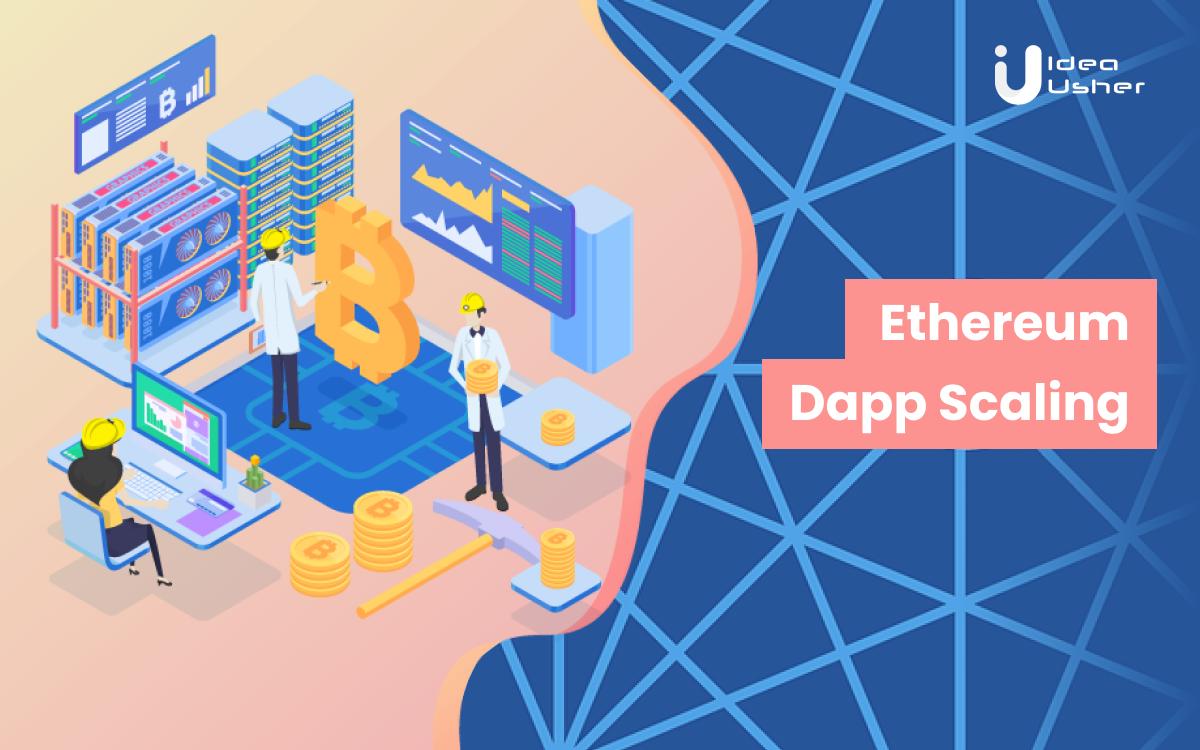
Cryptocurrency is often synonymous with Bitcoin to a lot of people. But the recent few years have shown a growing interest in other cryptocurrency platforms, too, as more and more people join the crypto bandwagon. One of the biggest emerging platforms is Ethereum.
When Bitcoin’s prices rose in 2017, crypto-enthusiasts needed a platform where they could build their own token. Ethereum proved to be the ideal solution as; literally, and anyone could build a coin here that also within an hour. A lot of coins were churned out at this time-most of them useless.
As Ethereum literally became a token-building machine, a few projects started which weren’t really token-based. Instead, they took advantage of Ethereum’s Smart Contract technology to build real, decentralized applications (Dapps). In today’s date, when the crypto market is seeing major ups and downs, developers have continued to build some amazing usable dApps.
Things haven’t changed much in terms of dApp adoption since last year. Currently, all Ethereum-based Dapps have around 27K users per day. Having said that, Ether volume on Dapps is increasing, and it is now around 22.98k ETH per month.
In this blog, the experts of Idea Usher will explain why and how we can scale Ethereum Dapps.
What is an Ethereum Dapp?
Before knowing the answer to that, we must know a little about Ethereum itself. Although it is worth mentioning here that other protocols like EOS, NEO, Stellar, Tron, and Cardano are also being used to build Dapps, Ethereum remains the choice for the majority of people.
So, what is Ethereum?
Ethereum is a network protocol that enables users to create and execute smart contracts on a decentralized network. A smart contract is made up of code that performs specific operations and interacts with other smart contracts, and it must be written by a developer. In contrast to Bitcoin, which stores numbers, Ethereum stores executable code.
Like Bitcoin removes the need for someone to store your money, Ethereum removes the third-party deal broker who handles the transaction between people. It is replaced by code, reducing time, cost, and the possibility of human error.
The smart contract, including codes and transactions, is reserved in multiple secured computer nodes, part of a global network. They are constantly being kept up-to-date so that everyone has the exact same copy. This is what makes smart contracts decentralized, in a way.
Coming back to Dapps, it is just another software application- a website or a mobile app. The difference lies in the fact that instead of native platforms, these are built on decentralized platforms like Ethereum.
Just like any other traditional apps, Dapps too have a user interface, the only difference being all or part of its backend is built on top of Ethereum.
Dapp = frontend + smart contract backend
The backend code is written in Ethereum-friendly code like Solidity (the most popular), Serpent, and Vyper. For the front end, you can use any language/framework you want; there is no specific language you need for Dapp.
Scope of Ethereum Dapps

Despite the fact that numerous blockchain networks are venturing into the market, Ethereum dApps are certain to rule the future of decentralized applications. The top three Ethereum dApps are worth $19 billion more than the top three EOS dApps!
Benefits of Ethereum Dapps
1. Open system
Open system Ethereum dApps demonstrate the platform’s full functionality to the network of participants. Your users will have more trust in you if you use an open-source protocol.
2. 100% smart contracts
Smart contracts automate the entire chain by eliminating manual processes and relying on coded agreements.
3. Encryption protocols
Ethereum dApps protect your users’ data and funds with cryptographic encryption protocols that protect the information in ciphertexts.
4. Decentralized Finance (DeFi)
Because decentralization is the driving force behind both domains, decentralized finance (DeFi) can be integrated into your decentralized ethereum Dapp.
5. Trustworthy
The highly transparent nature of ethereum dApps (decentralized applications) lends credibility to the platform and makes it trustworthy when compared to other opaque businesses.
6. Lego-blocks
Ethereum dApps function as Lego blocks, meaning that many decentralized applications can be built on top of one to provide quick access to other Dapps.
Ethereum Dapp development process
The entire development process takes place in the following few steps.
- Business consultation
- Ethereum Dapp wireframe
- Ethereum Dapp development
- Dapp testing
- Deployment
- Maintainance
Why do we need to scale Dapps?
Before answering how to scale Ethereum Dapps, we need to know why should we do so. As the number of people who use Ethereum has increased, the blockchain has reached capacity limits. This has increased the cost of using the network, necessitating the use of “scaling solutions.” Several solutions are being researched, tested, and implemented that take different approaches to achieve similar goals.
Most blockchain networks in general, including the Ethereum blockchain, face issues of scalability, transaction latency, and high transaction fees. Share on XThe primary goal of scalability is to increase transaction speed (faster finality) and transaction throughput (high transactions per second) while maintaining decentralization and security (more on Eth2 vision). High demand on the layer 1 Ethereum blockchain causes slower transactions and nonviable gas prices. Increasing network capacity in terms of speed and throughput is critical to Ethereum’s meaningful and widespread adoption.
While speed and throughput are important, scaling solutions that enable these goals must remain decentralized and secure. Maintaining a low barrier to entry for node operators is critical to avoiding a shift toward centralized and insecure computing power.
Prerequisites of scaling Dapps
You should be well-versed in all of the fundamental topics. Scaling solutions are more advanced because the technology is less battle-tested and is still being researched and developed.
On-chain vs off-chain scaling
There are two types of scaling running side-by-side
- On-chain scaling
- Off-chain scaling
On-chain scaling
Any increase in capacity at the core blockchain layer is referred to as on-chain scaling. An increase in the amount of data that can fit in each block is the most common on-chain scaling prescription. You can fit more transactions into each 13-second block interval by increasing the data limit.
Off-chain scaling
Off-chain scaling commonly refers to the creation of additional layers capable of handling transactions without relying on the core blockchain. Off-chain scaling examples include batching multiple payments into a single transaction, payment channels, and sidechains. The core idea behind off-chain scaling is that the main blockchain should only be used as a trust and arbitration layer.
How to scale Ethereum Dapps?

1. Scaling Ethereum Dapps through State Channels
State Channels allow users to conduct peer-to-peer transactions ‘off-chain,’ only sending messages onto the main chain when they want to exit the channel. They are built in the same way as Bitcoin’s Lightning Network. They are essentially payment channels in which users transact value outside of the main chain and only return to it to settle the channel. It’s very similar to a bar tab. State channels are particularly intriguing because they enable users to send state updates, such as smart contract updates, rather than just money.
Advantages of State Channels
The main point in favor of this technology is that it is functionally straightforward. If you and your friend want to send some ETH to each other, you expect to send through multiple transactions. But instead, you can conduct all payments off-chain, coming back to the main chain once all transactions are over.
2. Use the technology provided by the Ethereum “Casper Protocol”
Casper is a protocol that will convert Ethereum’s current Proof of Work (PoW) model to Proof of Stake (PoS). Miners must currently expend energy in order to solve a cryptographic equation and mine a block using PoW. They are rewarded if they solve the equation, but the process consumes a tremendous amount of energy (and will continue to require more and more). This is costly and inefficient, with the PoW model currently costing $1.2 billion USD per year to maintain.
In PoS, “validators” take the place of miners and “validate” (rather than mine) blocks onto the blockchain. Validators stake their funds on a specific block rather than expending energy on it. The block with the greatest amount of money staked on it is verified and added to the blockchain. Validators essentially “bet” that a specific block will be added to the chain by locking their funds in a contract until the next block is added. They will be rewarded if they bet on the correct block. They will lose their funds if they act maliciously by attempting to validate a block with incorrect or corrupt data.
Advantages of Casper Protocol
In theory, this change should protect the blockchain from malicious attacks. A failed attack on the blockchain costs the attacker time and power in PoW. A failed attack on the blockchain directly costs the user money in PoS, as s/he immediately loses all funds staked on the incorrect block.
3. Scaling by using “Sharding” technology
Sharding is the process of horizontally splitting a database to spread the load. In the context of Ethereum, sharding reduces network congestion and increases transactions per second by forming new chains known as “shards.” This will also reduce the workload for each validator, as they will no longer be required to process the entirety of all network transactions.
Sharding is also one of the most complicated solutions on Ethereum’s roadmap, with much more research and testing required before it can be implemented. Ethereum developers, in particular, must create a cross-shard communication mechanism that will allow smart contracts on one shard to communicate with smart contracts on different shards.
Advantages of “Sharding”
Blockchain sharding will be critical in addressing the scalability issues of blockchain systems, as it will aid in scaling down the Ethereum blockchain, increasing the number of transactions it can process in a second.
4. “Plasma” as a scaling solution
Plasma is another scaling method that handles transactions “off-chain,” that is, not on the main Ethereum blockchain. Plasma enables many blockchains (referred to as “child chains”) to branch off from the original blockchain (referred to as the “root chain”). As a result, each child chain can process and maintain its own transaction records while relying on the root chain’s underlying security. With Plasma, the root chain is the global enforcer of all the child chains’ computations.
The root chain, on the other hand, must be computed only if a dispute arises within one of the child chains. This method allows an entire network of child chains to divide up all blockchain transactions in order to optimize speed and efficiency. Nodes on a child chain can submit an exit transaction and export a record of their transactions to the root chain if they so desire.
Advantages of “Plasma”
One of the biggest strengths of this method is that each of these plasma chains has its own quality and set of standards. This means that different child chains can support transactions with varying requirements (for example, privacy) while remaining within the same secure ecosystem.
5. Use the technology of “Raiden Network”
Raiden is another off-chain scaling solution that allows nodes to keep a record of each other’s transactions without requiring the root chain to verify each transaction. A “state channel,” which is a two-way channel between users, can be established between two nodes. “Messages” — in the form of transactions — are exchanged between the two nodes and are signed by both parties to ensure immutability. Raiden is especially useful for frequent and predictable payments, such as a user who knows they will pay a company $20 per week for a service or a user who knows they will spend money at their local restaurant on a regular basis.
The root chain is freed of massive amounts of traffic because transactions are recorded and verified between these two nodes rather than on each block. Any participant in a state channel can choose to close the transaction at any time, and the net result of all transactions is exported to the root blockchain and included in the next block. That means that after a year of paying $20 per week, the user could have the block verify one $600 transaction rather than 30 separate $210 transactions.
Advantages of “Raiden Network”
Using the Raiden Network can reduce the gas fees for each transaction to a large extent. Transactions between nodes that occur off-chain require less gas to process than transactions that occur on the root chain.
Final words
Ethereum was the first network that allowed developers some amazing applications with a massive global outreach over the years. As it stands today, Ethereum has thousands of people working on scaling. This is bound to have its influence in the coming time resulting in a better user experience and reduction in transaction fees. This will only lead to a more robust network that is cheaper and easier to use.

Why is there a need for so many scaling techniques?
- Multiple solutions can help reduce overall network congestion while also preventing single points of failure.
- The sum of its parts is greater than the sum of its parts. Different solutions can coexist and have an exponential effect on future transaction speed and throughput.
- Not all solutions necessitate the use of the Ethereum consensus algorithm directly, and alternatives can provide benefits that would be difficult to obtain otherwise.
- No single scaling solution is sufficient to realize the eth2 vision.
How Idea Usher can help you?
At Idea Usher, we build Dapps that have a long-term scalable vision and can withstand the constantly changing environment of Blockchain without too much instability.
Contact us for more Dapp-related information.
FAQ
Q. Which is the best database for building scalable Dapps?
A: There are many options, but most developers usually go for Ethereum, Polygon, and Fauna.
Q. What is a Dapp?
A: Dapp, which stands for Decentralised Application, is a decentralized network-based app with no single centralized authority or server.
Q. Which blockchain has the greatest number of DApps?
A: Ethereum’s blockchain has the highest number of Dapps.









Shrestha Bhadra